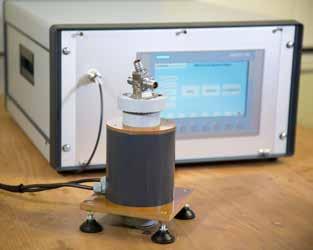
5 minute read
Assembly Considerations
Affixing magnets to housings:
Magnets can be successfully affixed to housings using adhesives. Cyanoacrylate adhesives which are rated to temperatures up to 180 C with fast cure times avoid the need for fixtures to hold the magnets in place while the bond cures. Adhesives with higher temperature ratings are also available, but these require oven curing and fixturing of the magnets to hold them in a vacuum. Potential outgassing of the adhesives should be considered.
Advertisement
Mechanical fastening:
When arrays of magnets must be assembled, especially when the magnets must be placed in repelling positions, it is very important to consider safety issues. Modern magnet materials such as neodymium are extremely powerful, and when in repulsion they can behave as projectiles if adhesives were to break down. It is recommended that in these situations mechanical fastening be included in the design in addition to adhesives. Potential methods of mechanical retention include encasement, pinning, or strapping the magnets in place with non-magnetic metal components.
Potting:
Magnet assemblies may be potted to fill gaps or to cover entire arrays of magnets. Potting compounds cure to hard and durable finishes and are available to resist a variety of challenging environments, such as elevated temperatures, water flow, etc. When cured, the potting compounds may be machined to provide accurate finished parts.
Welding:
Assemblies which are required to be hermetically sealed can be welded using either laser welding (which is not affected by the presence of magnetic fields) or TIG welding (using appropriate shunting elements to reduce the effect of magnetic fields on the weld arc). Special care should be taken when welding magnetic assemblies so that the heat dissipation of the weld does not affect the magnets.
Magnetisation:
Permanent magnet materials are composed of small regions or “domains” each of which exhibit a net magnetic moment. An un-magnetised magnet will possess domains which are randomly oriented with respect to each other, providing a net magnetic moment of zero. Thus, a magnet when de-magnetised is only de-magnetised from the observer’s point of view. Magnetisation is achieved by exposing the magnet to a very high magnetic field, the strength of which depends on the type of magnet material. The magnetic field aligns the domains to give a net, externally observable field.
It is important when magnetising a magnet to always magnetise the magnet to saturation, even if it will subsequently be de-magnetised for calibration or stabilisation purposes. Saturating the magnet and then de-magnetising it in a controlled manner ensures that the domains with the least commitment to orientation will be the first to lose their orientation, thereby leading to a more stable magnet.
Not achieving saturation, on the other hand, leads to orientation of only the most weakly committed domains, resulting in a less stable magnet.
Magnetisation
Saturation (All magnetic domains aligned)
Partially magnetised condition
Unmagnetised condition
In general, permanent magnets are supplied with a simple 2 pole magnetisation pattern: a North pole on one face and a South pole on the opposite face. However, by appropriate configuration of the magnetising coils it is possible to construct a fixture that will magnetise a magnet with many pole-pairs, and for some materials, pole patterns on a single surface of the magnet. This is called multi-pole magnetisation.
Anisotropic magnets, typically sintered magnets such as sintered NdFeB or ceramic magnets, have a preferred direction of magnetisation which gives them higher magnetic properties than isotropic magnets of the same material. These magnet materials must be magnetised parallel to the preferred direction to achieve these optimum magnetic properties. Consequently, these materials are not generally suitable for multipole magnetisation and such assemblies have to be constructed from individual pre-magnetised segments. However, isotropic magnets have no preferred direction and can therefore be magnetised in any direction, making them ideally suitable for multi-pole magnetisation in a single operation. This is one of the key advantages of Bremag ® bonded magnets. Bremag ® is a trademark of Bunting bonded materials.
Magnetising Patterns
Diametrical Radial Parallel to Length
Radial Through Arc Segment Straight Through Arc Segment Parallel to Thickness Multiple Poles
Magnetising Fixtures/Tooling:
Magnetisation is a key step in the manufacture of any permanent magnet component and it is usually the last stage in the manufacturing process. While simple 2 pole magnets can be magnetised in one of our standard solenoid magnetising coils, multi-pole magnets need their own custom made fixtures. Bunting designs and manufactures all its own magnetising fixtures either for use in house or to be used on customers’ own equipment. Due to the high energies required to generate the magnetising fields, particularly for rare-earth magnets, production magnetising fixtures are designed with water cooling and safety interlocks to protect the operators. These features also ensure the fixtures can never be operated with the wrong settings and result in only partially magnetised components. Production fixtures are built for the life of a project.
Prototype Magnetising Fixtures/Tooling:

For development projects, prototype fixtures can be built quickly after design. These allow for a small quantity of magnets to be magnetised and built into a prototype build program. Prototypes usually do not have built in cooling or interlock features and can only be guaranteed for small volumes.
Pre-assembly and post-assembly magnetisation:
For customers who wish to bring the magnetisation process in house, Bunting can supply turnkey magnetising systems for integration into a production line. This can range from magnetising fixtures to run on customers’ own magnetising equipment or full systems which include both the capacitor discharge magnetising unit and fixtures.
Bunting manufactures its own capacitor discharge units, which are all PLC controlled and therefore can be integrated into the customer’s own production lines. The units employ all the same interlock and safety features for production including magnetisation fixture temperature control. Through appropriate consultation with customers, Bunting will manage the process to ensure the magnetising system meets the production requirements in the most efficient way. From a production point of view, the most desirable approach is to build a multi-pole magnet assembly with un-magnetised magnets and then magnetise the assembled device as the final step in the manufacturing process. This avoids all the production issues associated with handling and locating very strong magnets. This process is called post assembly magnetisation. Multi-pole magnetising fixtures can be built to post-assembly magnetise customers own assemblies or those assembled by Bunting. It is not always possible to achieve 100% saturation throughout the magnet volume, but the effect of this can be simulated by Bunting using our specialised FEA software. This software allows customers to assess if the practical and cost advantages of post assembly outweigh the disadvantages of a slight drop in performance.









